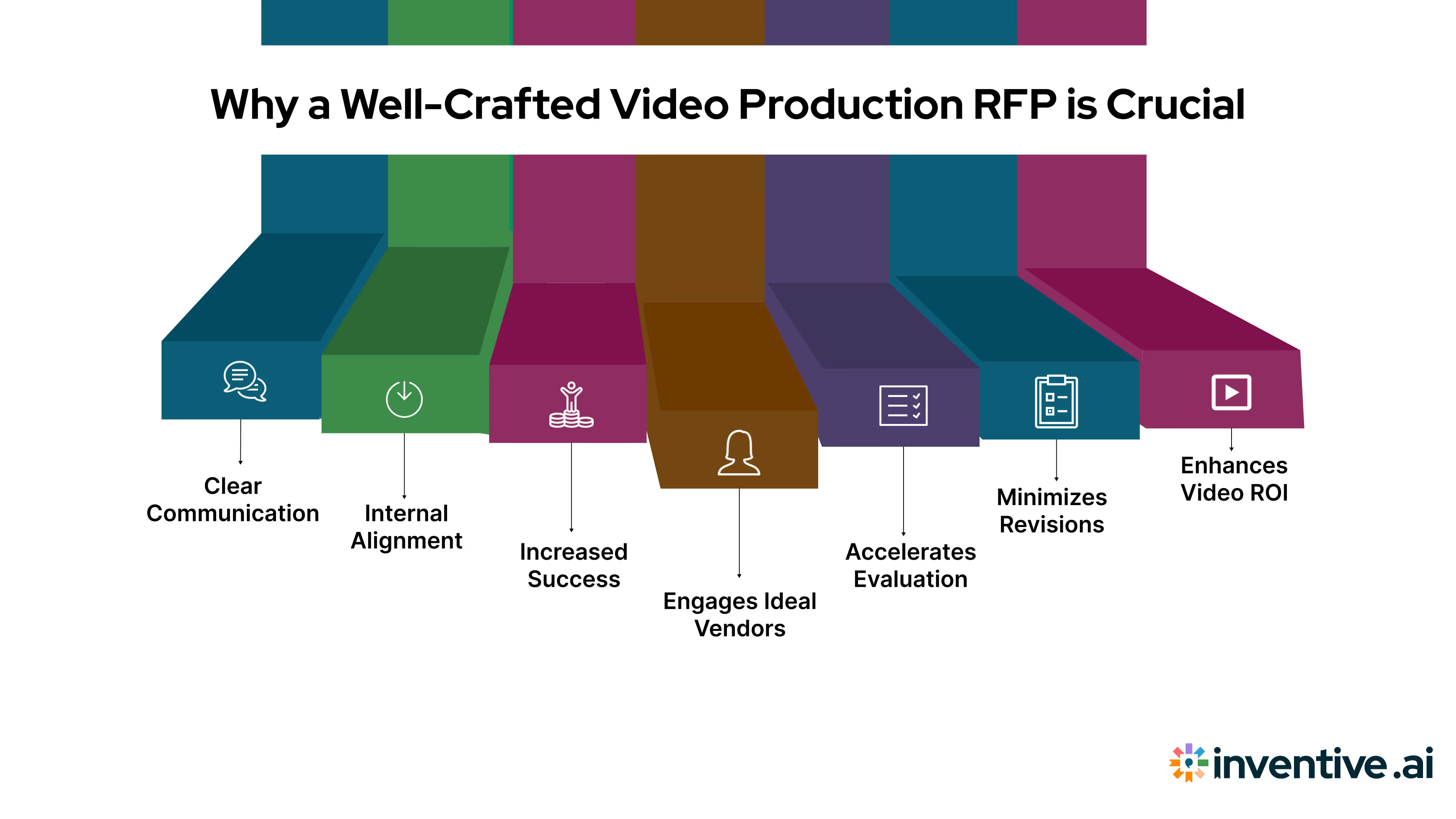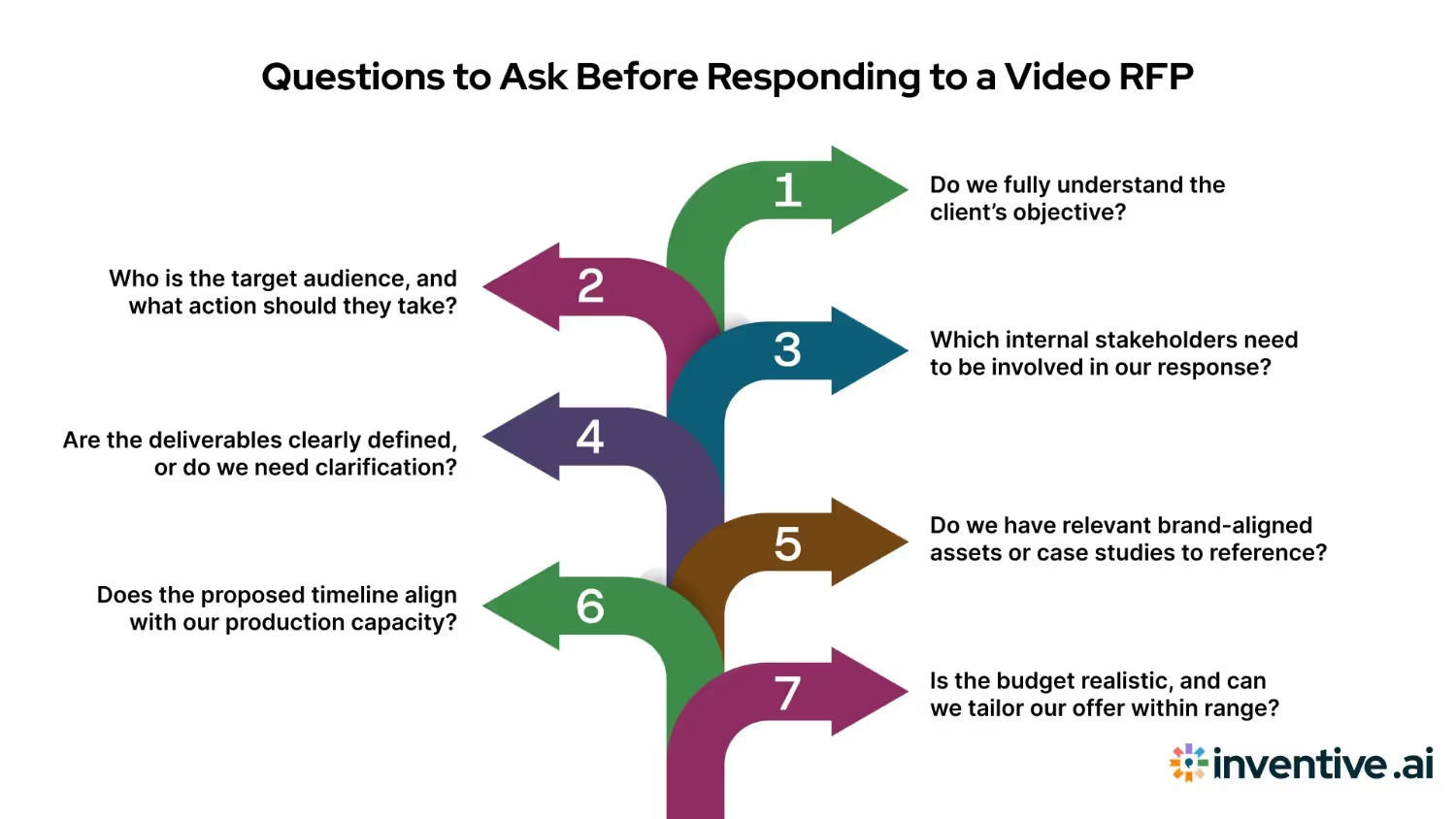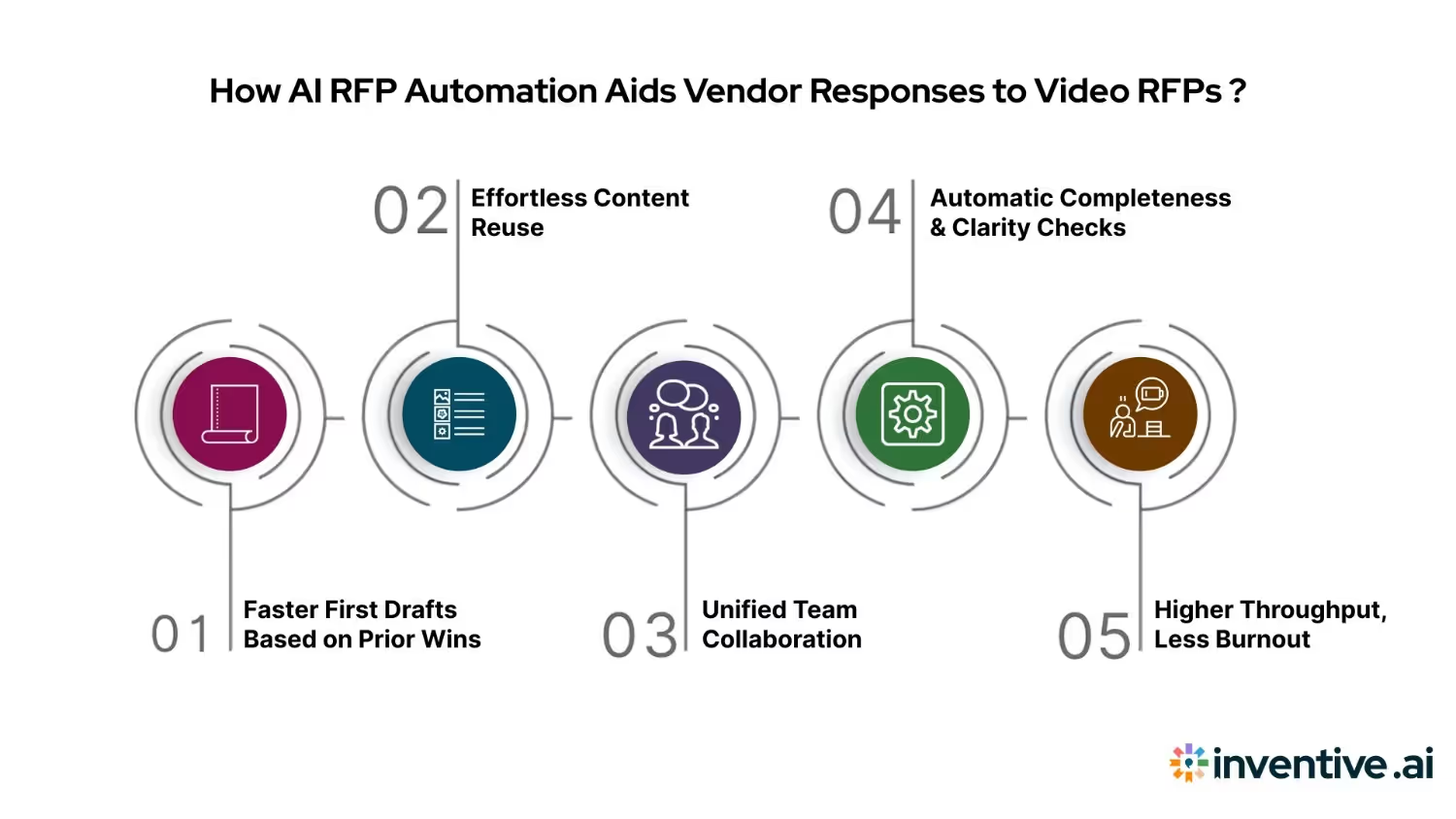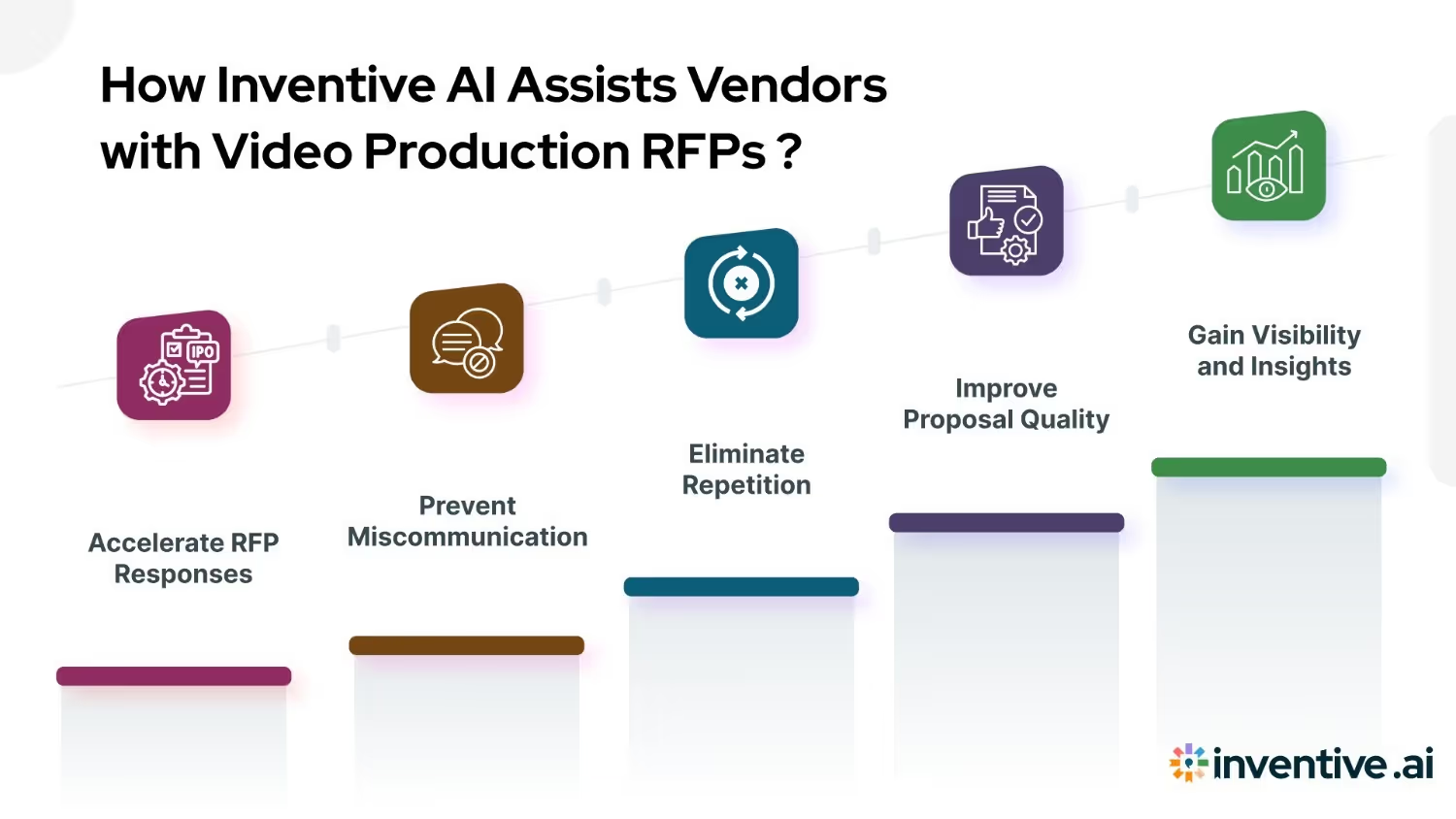Understanding Video Production RFPs: Respond Faster
Craft a strong video production RFP by defining project goals and deliverables and specifying your target audience. Set clear budget caps and streamline vendor submissions with key evaluation criteria. Download our guide now!

Introduction
Video production RFPs are becoming more common in brand campaigns, product launches, and social content strategy. But for sales, marketing, and proposal teams on the vendor side, responding to these creative RFPs is slow, disorganized, and manually intensive costing you deals, time, and team bandwidth.
On average, vendors spend 20–38 hours per RFP response. When each document includes vague scopes, incomplete timelines, or unclear creative expectations, your team wastes time interpreting briefs instead of focusing on strategic proposal work.
That’s why understanding how clients structure a video RFP is critical not just for creative alignment, but for increasing win rates and reducing rework. And when paired with AI-powered RFP automation, your team can scale proposal volume without sacrificing quality.
In this guide, we’ll reverse-engineer what goes into a strong video production RFP so your team can respond faster, more strategically, and with proposals that actually win.
TL;DR
- A video production RFP is a formal document that outlines your project goals, audience, timeline, budget, and creative requirements, used to source proposals from qualified vendors.
- A well-crafted RFP improves clarity, reduces back-and-forth, filters for the right creative partners, and increases your chances of receiving on-target proposals.
- Project overview, objectives, target audience, scope of work, timeline, budget, creative direction, evaluation criteria, and submission instructions.
- Ask internal questions to clarify goals, deliverables, stakeholders, creative references, and deadlines.
- AI RFP automation tools accelerate drafting, centralize collaboration, reduce errors, and reuse content, saving hours of manual effort.
What is a Video Production RFP?
A video production RFP (Request for Proposal) is a structured document issued by companies seeking creative partners for projects like brand films, product launches, or social campaigns. It outlines critical information, project goals, target audience, creative direction, budget, and timeline, to guide vendors in submitting tailored proposals.
For vendors, this RFP acts as the blueprint for what the client expects and values. It’s your first window into the client’s priorities, creative style, and success criteria, making it the foundation of your proposal strategy.
Why does this matter? Because video content has become a top-performing asset. According to Sprout Social, short-form video delivers the highest ROI of any social content. 93% of marketers report strong ROI from video marketing, making it a pivotal part of most brand strategies in 2026.
Understanding how video RFPs are structured allows your team to:
- Prioritize proposal content around what clients actually care about
- Identify scope red flags early
- Customize responses based on project type (animation vs. testimonial, etc.)
In high-stakes, fast-moving creative bids, a clear grasp of the RFP structure helps your team respond faster, smarter, and more competitively, especially when supported by platforms like Inventive AI.
Why Does a Well-Crafted Video Production RFP Matters?

RFPs are not all the same, and for proposal teams on the vendor side, the quality of the RFP has a direct impact on how fast and efficiently you can reply. Inconsistent or ambiguous video production RFPs cause your team to lose time interpreting requirements, obtaining internal input, or sending off-target responses.
But a well-written RFP? That’s a launchpad for strategic, winning proposals, especially when paired with AI-powered tools that help you respond at scale.
Here’s why getting your RFP right is so critical:
1. Clear Communication
A detailed RFP eliminates guesswork by outlining exactly what you expect such as creative direction, deliverables, timelines, and budget range. When agencies understand your goals from the start, they’re more likely to deliver proposals that hit the mark.
2. Aligns Stakeholders Internally
When marketing, brand, and leadership teams all have input, a central RFP ensures everyone is on the same page. It brings together expectations, messaging, and creative vision into one shared document, reducing the risk of conflicting feedback during production.
3. Higher Win Potential
When you can clearly map your solution to a client’s objective, without missing technical specs or budget parameters, you increase your odds of standing out. AI helps ensure no requirement is overlooked, even in complex RFPs.
4. Attracts the Right Vendors
Top video production agencies are selective. A professional, well-scoped RFP signals that your team is organized and serious, increasing the chances of attracting high-quality, experienced partners who are a good fit for your needs.
5. Speeds Up the Evaluation Process
With clearly defined evaluation criteria and project requirements, it becomes easier to compare vendors side-by-side. This shortens the decision-making timeline and helps you move forward with the best creative partner faster.
6. Reduces Revisions and Scope Creep
When expectations are set early, there’s less room for misalignment. A strong RFP reduces back-and-forth during pre-production and minimizes costly changes later in the process, saving both time and budget.
7. Maximizes ROI from Video Marketing
With short-form video ranked as the top-performing content type for social media ROI (Sprout Social), there’s more pressure than ever to get video right. A well-structured RFP helps ensure your video content aligns with broader marketing goals and delivers real business outcomes. 21% of marketers say short-form videos deliver the highest ROI of any content type.
With the “why” covered, it’s time to break down the exact components your RFP should include, ensuring clarity, consistency, and vendor confidence. By integrating personalized content into your RFP responses, you significantly increase your proposal impact and win potential
How to Break Down a Video Production RFP?
A well-structured video RFP gives vendors the roadmap they need to craft a winning proposal. But when you’re working under tight timelines, reviewing dense, multi-page briefs, it’s easy to overlook important details or spend time duplicating work that already exists.
For sales, proposal, and creative teams, knowing how to interpret and extract the right information from an RFP is the first step toward building a compelling, relevant response.
Here's how to break down the essential components of a video production RFP so your team can respond with clarity, speed, and precision.
1. Project Overview
Look for a summary that explains the purpose of the video project. What’s the business context? Is this part of a campaign, launch, or internal initiative? Understanding this sets the tone for your proposal’s positioning and creative framing.
2. Objectives and Goals
This section tells you what the client hopes to achieve: awareness, engagement, education, or conversion. Use this to shape how you present your solution. A response that aligns directly with the client’s outcome goals stands out quickly.
3. Target Audience
Pay close attention to demographics, behavioral insights, or psychographic details. This will guide your tone, format, and messaging choices. A proposal that reflects an understanding of the viewer’s mindset demonstrates strategic thinking.
4. Scope of Work
Here you’ll find the specifics: number of videos, formats (e.g., explainer, testimonial), platform-specific versions, language requirements, and additional elements like scripting or voiceovers. Extract each deliverable and map your response to them point by point.
5. Creative Requirements
Clients may include style preferences, brand guidelines, or references to past videos they liked. These are creative cues and not just constraints. Use them to shape your proposed concept or visual approach in a way that matches their expectations without guessing.
6. Timeline and Key Milestones
Always note the critical dates: submission deadlines, selection windows, kickoff calls, and delivery expectations. Flag any tight turnarounds and ensure your team’s availability lines up before committing to a timeline in your proposal.
7. Budget Range
If provided, the budget helps scope your recommendations realistically. Be prepared to tailor creative solutions to fit different levels within that range. If no budget is mentioned, assess the task and provide tiered options if possible.
8. Evaluation Criteria
This is your scorecard. Clients often list what they value most i.e, creativity, experience, speed, pricing, or alignment with the audience. Shape your response to highlight those strengths and directly address how you meet (or exceed) their criteria.
9. Submission Guidelines
Check how they want to receive your proposal: email, portal, deck, or PDF. Double-check formatting preferences, supporting material requirements, and submission contacts. Missing small instructions here can disqualify a strong proposal.
Want to see what a complete, real-world RFP looks like? Download this Sample Video Production RFP Template to guide your internal documentation or prepare stronger vendor responses.
Before jumping into writing your RFP, it’s important to pause and reflect. Asking the right internal questions upfront can dramatically improve the quality and focus of your request.
Questions to Ask Before Responding to a Video RFP

Before jumping into proposal mode, it's important for vendor teams to pause and clarify their internal approach. Understanding the RFP is one thing, but aligning your response to client goals, internal resources, and business fit is what sets winning proposals apart.
Here’s a checklist of strategic questions to ask before you respond to a video production RFP:
1. Do we fully understand the client’s objective?
Is the video meant to raise awareness, explain a product, drive conversions, or train internal teams? Read between the lines. If the RFP doesn’t state the outcome clearly, reach out and ask. Aligning your proposal to the client's end goal is critical.
2. Who is the target audience, and what action should they take?
Understanding who will watch the video, and what the client wants them to do after, is essential to shaping messaging, style, and creative recommendations. Tailor your response to reflect the audience's needs and preferences.
3. Which internal stakeholders need to be involved in our response?
Identify early who needs to contribute i.e., sales, creative, legal, finance, and assign roles. Disjointed collaboration causes delays and incomplete responses. The earlier you organize, the faster you respond. If your team handles security reviews or questionnaires during the RFP process, consider tools like Inventive’s AI Security Questionnaire Software to streamline internal inputs and reduce back-and-forth.
4. Are the deliverables clearly defined, or do we need clarification?
If the RFP is vague about formats, duration, platform variations, or visual expectations, flag those for client clarification. Also, distinguish between “must-haves” and “nice-to-haves” to scope your effort and pricing correctly.
5. Do we have relevant brand-aligned assets or case studies to reference?
Pull examples that match the project’s style or goals, especially if they speak to similar industries or audiences. Reinforcing your creative credibility helps differentiate your proposal.
6. Does the proposed timeline align with our production capacity?
Look closely at the production deadlines. If any milestones feel rushed or unrealistic, flag them early. It’s better to address constraints upfront than risk missed expectations later.
7. Is the budget realistic, and can we tailor our offer within range?
If the budget is provided, assess whether it aligns with the scope. If it’s missing, consider offering multiple pricing tiers. And make sure internal stakeholders are aligned on what you’re willing to negotiate.
Asking these questions upfront helps your team respond with clarity, relevance, and confidence, rather than rushing to meet a deadline with an under-scoped or over-ambitious proposal.
Before your team responds, use this Video Production RFP Response Checklist to ensure every critical detail is covered starting from objectives and deliverables to timeline alignment and internal collaboration.
Check out this blog If you want to know how to write a proposal request that stands out.
How to Deconstruct a Video RFP and Craft a Winning Response?
Once you receive a video production RFP, the first step isn’t writing. It’s understanding. Knowing what the client is truly asking for helps your proposal team respond with clarity, creativity, and confidence. The best responses are aligned with the client’s goals, expectations, and language.
Here's how to break down the major sections of a typical video production RFP and shape a response that resonates with decision-makers:
1. Executive Summary: Set the Stage with Purpose
If the RFP includes a summary, use it to inform how you position your proposal. Reflect their language and restate the problem or opportunity in a way that shows you understand what’s at stake. When clients see themselves in your intro, you build instant credibility.
Example:
If the RFP says, “We’re launching a new mental wellness app for Gen Z audiences and need a 60-second explainer video,” your opening could read:
“You’re preparing to launch a Gen Z-focused wellness app, and need content that feels authentic, fast-paced, and emotionally resonant. We understand the importance of capturing trust in a saturated space, and this proposal outlines how we’ll help you do just that.”
2. Company Overview & Project Objectives
Use this section to identify what the company does, who they serve, and why this video matters now. Then, explicitly connect your capabilities and past work to those business drivers. Help the client see how your team advances their objective, not just executes tasks.
Example:
If the company is an enterprise SaaS platform aiming to explain a complex integration, reference a relevant win:
“As a B2B SaaS platform targeting IT decision-makers, your video needs to simplify a complex integration without oversimplifying the value. Our team helped [Client X] drive a 37% uplift in demo sign-ups through a similar product explainer for enterprise buyers.”
3. Scope of Work: Define Deliverables in Detail
Carefully extract and list every requirement mentioned: number of videos, duration, format, scripting needs, edits for different platforms. Mirror these in your response. Address any assumptions, gray areas, or scope gaps directly and professionally.
Example:
If they list “2 short videos + 1 cutdown for social,” your response could be:
“We’ll deliver two 60-second core videos optimized for web, plus a 30-second cutdown version tailored for Instagram Stories. Please confirm if vertical format is preferred for the social version.”
4. Budget and Payment Terms
If a budget range is provided, tailor your response within it. If not, outline clear pricing options and indicate flexibility based on scope adjustments. Transparency here builds trust. Be proactive about payment terms. Mention milestones, deposits, and review timelines if relevant.
Example:
“We’ve structured our proposal within your $10,000–$15,000 range. Option A focuses on high-impact animation; Option B includes custom VO and scripting. We suggest a 40% deposit at contract signing, 30% on storyboard approval, and 30% on delivery.”
5. Timeline and Key Milestones
Map the client’s timeline against your internal availability. Break your response into phased delivery schedules like concept, scripting, review cycles, final delivery. If anything feels tight, flag it early and suggest alternatives to avoid missed deadlines later.
Example:
“We can meet your September 5 final delivery date, assuming a kick-off by August 1. Our proposed milestones: script sign-off by August 10, animation review by August 22. We’ve built in a 2-day buffer for internal review rounds.”
6. Evaluation Criteria: What You’re Looking For
These are your success metrics. If creativity, speed, or strategy is listed, highlight case studies or results that demonstrate those capabilities. Craft your response to show not just what you do, but how you align with their decision-making criteria.
Example:
If they list “creativity” and “brand alignment” as key criteria:
“Your brand voice leans minimalist, calm, and professional. To match that, we’re proposing a soft color palette with kinetic typography instead of character animation, keeping the focus on messaging without visual noise.”
7. Submission Guidelines: Make It Easy to Respond
Double-check how the client wants your proposal formatted and submitted. Stick to their requirements exactly. Late or off-format submissions, even if creatively strong, often get discarded early in the review process.
Example:
“You requested a single PDF format with links to relevant work. Attached is a branded proposal (PDF), with embedded links to three past projects: [link]. We’ve also included a separate cost breakdown spreadsheet in the same email thread, as requested.”
Note: The best proposals don’t just meet requirements. They show the client you understand their business, speak their language, and respect their process. That kind of precision builds trust and puts you ahead of vendors who treat RFPs like forms.
Even the most well-structured RFPs can fall short if they contain common oversights. Let’s look at the most frequent mistakes and how to avoid them.
Common Mistakes Vendors Make When Responding to Video Production RFP
Even if your creative capabilities are outstanding, proposal missteps can quickly disqualify your team or weaken your chances of winning. With video RFPs becoming more complex, the risk of scope mismatches, underpricing, or vague responses is higher than ever.
Here are the most common mistakes proposal teams make when responding to video production RFPs, and how to avoid them:
1. Misinterpreting the Client’s Objective
Failing to read between the lines on “why” the client needs the video often leads to tone-deaf proposals.
Example:
The RFP says the goal is “internal alignment,” but your proposal focuses on marketing results. This signals you haven’t understood their intent, and someone else will win the bid by simply listening better.
Tip: Always restate their objective in your response to show alignment.
2. Ignoring Budget Guidelines or Skipping Pricing Structure
When vendors avoid addressing budget, or go wildly over/under, it shows poor scoping.
Example:
You quote $25,000 when the RFP hints at a $10–15k range. The client doesn’t see value, just misalignment.
Tip: Respond with options or tiered pricing if the scope isn’t crystal clear.
3. Using Generic or Fluff-Filled Language
Saying “We create engaging videos that tell your story” is meaningless if every other proposal says the same thing.
Example:
Five vendors use the same stock phrasing. The one that shows how they’ll do it, backed by work samples and tailored messaging, stands out.
Tip: Replace buzzwords with specifics. Use past work, client results, and project-relevant insights.
4. Missing Key Deliverables in the Scope
Overlooking details like platform-specific cutdowns, vertical formats, or voiceover requirements can hurt your credibility.
Example:
The client asks for 1 hero video + 3 social edits. You propose just the hero video, now they need to chase you for clarification, or worse, dismiss your bid as incomplete.
Tip: Create a checklist of requested assets and map your response to each one.
5. Failing to Address Evaluation Criteria
If the RFP outlines how they’ll score submissions, and your response doesn’t reflect that, you're missing a clear opportunity.
Example:
They prioritize “timeline efficiency” and “audience understanding”, but your proposal only talks about animation quality.
Tip: Use their criteria as your section headers or summary bullets where relevant.
6. Overpromising on Timelines
Agreeing to unrealistic delivery dates can win the bid, but risk damaging client trust if you can’t meet them.
Example:
You commit to a 3-week turnaround, but your internal pipeline is already full. Midway through, you request an extension, undermining professionalism.
Tip: Be honest about availability. Propose a timeline buffer to build confidence.
7. Fragmented Internal Collaboration
Disorganized responses often happen because sales, creative, legal, and ops aren’t synced during the response process.
Example:
Creative submits a concept deck, legal sends a terms doc in a different format, and the final proposal lacks cohesion.
Tip: Use shared folders, proposal tools, or AI-powered RFP platforms to streamline team collaboration.
These mistakes are avoidable, but only if you approach each RFP with discipline, clarity, and internal coordination. The best proposals are strategic, structured, and aligned with what the client actually asked for.
Now that you know what to avoid, let’s look at how AI tools can take your RFP process from time-consuming and manual to fast, intelligent, and scalable.
How AI RFP Automation Helps Vendors Respond to Video Production RFPs?

For creative and sales teams on the vendor side, responding to video RFPs is often a scramble, tackling vague scopes, reusing scattered content, and coordinating across departments under deadline pressure. That’s where AI RFP automation steps in.
Rather than starting from scratch each time, AI-powered RFP response platforms help your team respond to more RFPs, more accurately, and in far less time.
Here's how:
1. Faster First Drafts Based on Prior Wins
AI can generate structured, editable proposal drafts by analyzing past successful responses, similar client briefs, or historical campaigns. Whether it’s a 60-second explainer or a multi-format brand film, the system adapts to the specific creative format required.
Example:
Received a new RFP for an animated product demo? The AI pulls relevant scripting formats, voiceover specs, and visual direction based on past animation RFPs in your database, drafting 70% of the response instantly.
2. Smart Content Reuse Without Manual Copy-Paste
Instead of rewriting boilerplate content (company overview, creative process, compliance sections), AI identifies reusable blocks and adjusts them to the new brief’s tone and scope.
Example:
Your “client onboarding process” section gets reused, but the AI personalizes it to match the RFP’s industry (e.g., healthcare vs. SaaS) and tone (conversational vs. formal).
3. Centralized Collaboration Across Teams
Proposal success depends on alignment between creative, sales, and legal. AI platforms create a shared workspace to assign sections, track approvals, and manage internal feedback in one place, without chasing email threads or version conflicts.
Example:
Instead of juggling 6 Google Docs and 4 email chains, your proposal team works from a single interface, with section ownership and deadline alerts built in.
4. Auto-Checks for Completeness and Clarity
AI can detect missing deliverables, vague descriptions, or conflicting timeline details before submission, helping teams catch errors early.
Example:
You forgot to include subtitled cutdowns in the deliverables? The AI flags that based on the platform section referencing “LinkedIn & Instagram Reels” and suggests a clarification block before submission.
5. Better Throughput Without Burnout
With AI handling the heavy lifting on structure, formatting, and reuse, your team can respond to more RFPs per quarter, without sacrificing quality or stretching resources thin.
Example:
What took your proposal manager 12 hours now takes 4, with time left over to fine-tune the creative concept, not just copy-edit the boilerplate.
Whether you're a vendor responding to one RFP a month or managing multiple video bids per week, AI RFP automation gives your team the edge to work smarter, not harder, and win more of the right projects, faster.
How Inventive AI Helps Vendors Respond to Video Production RFP?

Marketing teams spend countless hours drafting video production RFPs, chasing stakeholder input, and formatting requirements. As timelines tighten and creative demand grows, writing and managing RFPs becomes a bottleneck, slowing vendor selection and compromising campaign timelines.
When you're managing high-stakes deliverables, product launches, brand films, campaign videos, you can’t afford delays, misalignment, or vague documentation. The traditional RFP process simply doesn’t scale with the pace of modern content production.
That’s where Inventive AI comes in.
Inventive AI’s AI-Powered RFP Response Software helps marketing and brand teams move from static documents and fragmented approvals to a centralized, intelligent RFP creation workflow, without compromising creative depth or cross-functional accuracy.
Here’s how it delivers real-world impact for video production RFPs:
Accelerate RFP Responses Without Starting From Scratch
Inventive AI accelerates your team’s ability to respond to video production RFPs by generating highly relevant first drafts in minutes. By analyzing incoming RFPs and pulling from your approved content library, past proposals, and team inputs, it creates tailored responses aligned with the project type, whether it's a live-action testimonial, animated explainer, or social media ad.
NLP-trained models detect the nature of the RFP and intelligently fill in key sections like project scope, technical specs, and creative workflows, giving your team a structured, editable draft that’s 70–90% complete before you even start writing.
Instead of starting from zero every time, your team works faster and smarter, with proposals that reflect both your creative strengths and the client’s expectations.
Prevent Miscommunication Across Teams
Cross-functional collaboration is essential in video production, and Inventive AI ensures all stakeholders stay aligned through a role-based collaboration workspace. Marketing, brand, legal, and procurement teams can work together in a single platform where they can assign sections, manage version control, track approvals, and leave real-time feedback. The platform integrates with Slack and Microsoft Teams, making it easy to eliminate miscommunications that often occur in scattered documents or long email threads. So teams don’t have to waste time chasing feedback or duplicating reviews across disconnected platforms.
Eliminate Repetition With Smart Content Reuse
Inventive AI minimizes repetitive work by leveraging a library of reusable, pre-approved content blocks, such as legal disclaimers, technical specs, and creative brief templates. These blocks are intelligently inserted into new RFPs using advanced content mapping and tagging. The platform ensures the right materials are pulled in based on the type of project and its specific scope, enabling teams to respond to higher volumes of RFPs without increasing headcount.
Improve Proposal Quality and Vendor Clarity
To ensure your RFPs are production-ready, Inventive AI automatically flags any incomplete, outdated, or unclear sections before the document is finalized. This reduces ambiguity and increases the quality of vendor responses. The platform’s AI-powered validation engine checks for missing technical specs, like aspect ratios, resolution formats, or unsupported deliverables, as well as timeline inconsistencies and unscoped revisions, helping you avoid costly delays or misunderstandings during production.
Gain Visibility and Insights Across Your RFP Workflow
With its built-in analytics dashboard, Inventive AI provides real-time visibility into your team’s RFP performance. You can track average RFP creation times, content reuse rates, team bottlenecks, and win/loss trends. The data is exportable in CSV or Excel format and includes user-level audit trails, allowing marketing leaders to make more informed decisions, optimize workflows, and continuously improve their RFP output and outcomes.


Here’s why it matters to creative and marketing teams -
- Respond up to 10x faster to creative needs without sacrificing strategy.
- Eliminate scope confusion that slows vendor onboarding or leads to mid-project delays.
- Streamline reviews across legal, brand, and procurement in one unified flow.
- Ensure brand consistency across all vendor-facing documents.
- Scale campaign production without increasing team workload or headcount.
Conclusion
Responding to video production RFPs doesn’t have to be a slow, manual, or fragmented process. With more clients requesting detailed creative scopes, and timelines getting tighter, proposal teams need to move faster, without sacrificing clarity, quality, or alignment.
The most successful vendors treat the RFP not just as a formality, but as a strategic opportunity. By breaking down RFP components methodically, tailoring proposals to client goals, and leveraging the power of AI RFP automation, your team can respond faster, reuse winning content, and focus more time on what actually closes deals.
Whether you’re responding to your first creative RFP or managing multiple proposals a week, AI-powered RFP tools help you scale output, improve quality, and win more projects with less effort.
FAQs
1. What should be included in a video production RFP?
A comprehensive video production RFP should include a project overview, objectives, target audience, scope of work, creative requirements, timeline, budget range, evaluation criteria, and submission guidelines. The more detailed your RFP, the better responses you’ll receive from potential vendors.
2. Do I need to include my budget in the RFP?
Yes. Including a budget range helps vendors understand the scale of your project and tailor their proposals accordingly. It also filters out partners who are not a fit financially, saving time on both sides and leading to more realistic, feasible proposals.
3. How long should a video production RFP be?
There’s no fixed length, but the RFP should be as detailed as necessary to communicate your goals, requirements, and expectations. Typically, 3–5 pages is sufficient for most projects. Focus on clarity over length. Vendors need clear direction, not filler.
4. When should I use an RFP for video production?
Use an RFP when you’re working on a high-impact project (e.g., product launch, brand video), evaluating multiple vendors, or coordinating input from multiple departments. An RFP helps align teams and sets a consistent standard for vendor responses.
5. Can AI help with responding to video production RFPs?
Absolutely. AI RFP automation tools help vendors respond to complex video production RFPs by generating tailored first drafts, reusing high-performing content, and streamlining internal collaboration. These platforms also flag incomplete or misaligned sections, ensuring proposals are complete, accurate, and aligned with client expectations , all while cutting response time by up to 70%.


